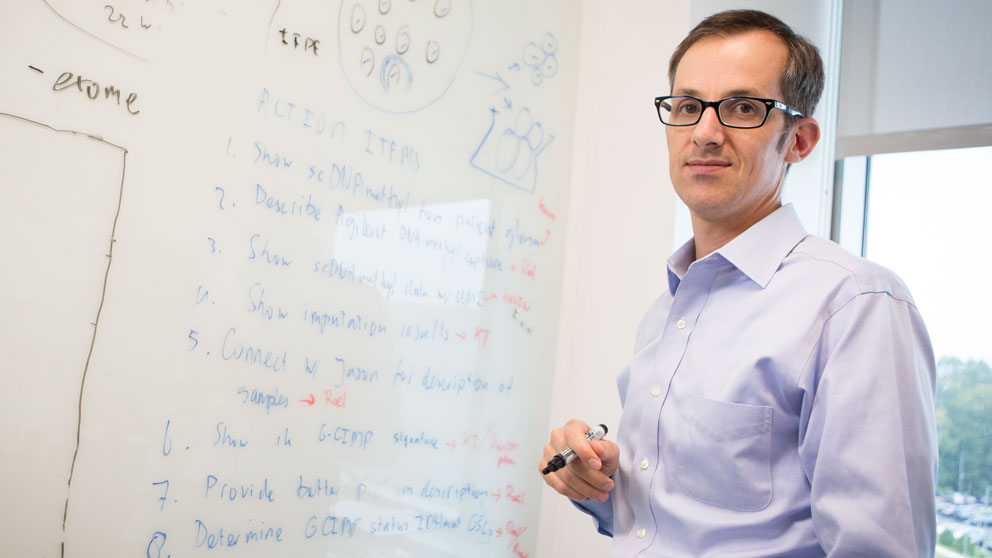
JAX research team led by Professor Roel Verhaak, pictured above, reports in Cancer Discovery important new insights into the biology of ecDNAs and their potential contributions to cancer. Photo by Tiffany Laufer.
Extrachromosomal DNA elements (ecDNAs) are frequently detected in cancer and drive activation of oncogenes (cancer-promoting genes) via increased gene expression. Recent research has revealed that the presence of ecDNAs associates with poor survival, potentially as ecDNAs contribute to heterogeneity (differences between cells). It was suspected that the differences in ecDNA distribution resulted from uneven segregation during mitosis (cell division), but it had yet to be experimentally confirmed.
In “Live-cell imaging shows uneven segregation of extrachromosomal DNA elements and transcriptionally active DNA hubs in cancer,” published in Cancer Discovery, a team led by Jackson Laboratory (JAX) Professor Roel Verhaak, Ph.D., and , presents important new insights into the biology of ecDNAs and their potential contributions to cancer. The researchers used an innovative new CRISPR-based method, named ecTag, to visualize ecDNAs in living cells, including during mitosis. The study showed disjointed ecDNA inheritance, as well as the formation of ecDNA “hubs” in daughter cells that likely play a role in enhanced gene expression and cancer initiation.
Disjointed inheritance
While existing staining and labeling methods have allowed ecDNA to be visualized, they only work with fixed cells, so ecDNA dynamics in living cells remained largely unknown. And ecDNAs have been difficult to detect through sequencing, as they carry DNA sequences also found on chromosomes. But they do have one unique sequence location—where the two ends of the DNA meet up to form the circle, known as the breakpoint junction. Verhaak and his team therefore developed ecTag, which, like CRISPR, uses a guide RNA to locate and bind with specific DNA sequences, in this case at the ecDNA breakpoint junction. Instead of active Cas9 that cuts the DNA, however, ecTag uses Casilio, a molecular tool that can localize fluorescent markers at the sequence and label it for visualization in living cells.
Applying ecTag to a cell line derived from a patient glioblastoma sample, the team was able to determine the number of ecDNAs in daughter cells after mitosis. When cells divide, there are robust mechanisms to ensure the accurate duplication and division of chromosomes so that each daughter cell inherits them correctly. But ecDNAs are not involved with that elaborate process, and ecTag showed that they are indeed inherited randomly, with different numbers frequently present between daughter cells. Following the cells through multiple division cycles, the researchers continued to see highly variable numbers of ecDNA in the growing population of cells, indicating that they are likely to contribute to tumor cell heterogeneity.
Clustering of ecDNAs drives oncogene activation
Using ecTag also revealed where ecDNAs localize within cells for the first time. Verhaak and the team found that they tend to cluster together, in so-called ecDNA “hubs,” in a majority of cells. Of particular interest was the finding that the hubs recruit an enzyme, RNA polymerase 2, to them, a key component of increased transcriptional activity and oncogene expression.
“Observing the formation of ecDNA hubs that recruit RNA polymerase was an exciting part of the study,” says Yi. “It provides a plausible mechanism to explain why the oncogenes on ecDNAs are expressed at such high levels and how they contribute to the diversity of cancer cells.”
The study provides vital confirmation that some of the suspected properties of ecDNAs are in fact accurate. Still to be explored, however, are exactly how ecDNAs replicate during mitosis and form hubs within cancer cells. Understanding these mechanisms is likely to be an important step for developing therapeutics that target ecDNA and reduce or eliminate their contributions to aggressive, treatment-resistant cancers.